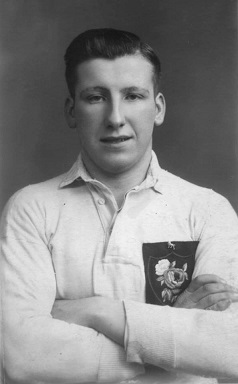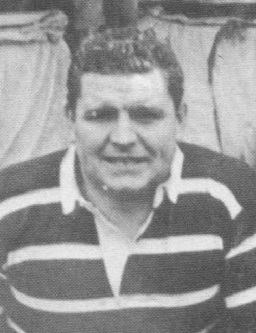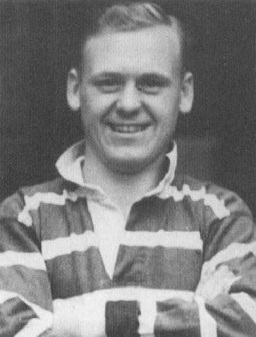Related Research Articles
Michael "Mick"/"Mike" Smith is an English former professional rugby league footballer who played in the 1960s and 1970s. He played at representative level for Yorkshire, and at club level for Featherstone Rovers, and Huddersfield, as a centre, or stand-off.

Donald "Don" Metcalfe was an English rugby union, and professional rugby league footballer who played in the 1950s and 1960s, and coached rugby league in the 1960s. He played club level rugby union (RU) for Sandal RUFC, and representative level rugby league (RL) for England (Under-21s), and Yorkshire (captain), and at club level for Featherstone Rovers (captain), and Wakefield Trinity, as a fullback or centre, and coached at club level for Keighley.
Gary Cooper, also known by the nickname of "Super Duper" Gary Cooper, was an English professional rugby league footballer who played in the 1950s, 1960s and 1970s, and coached in the 1970s. He played at representative level for Great Britain, and at club level for Featherstone Rovers (captain), and Wakefield Trinity, as an occasional goal-kicking fullback, or centre, and coached at club level for Wakefield Trinity, and York.
Dennis Baddeley was an English professional rugby league footballer who played in the 1940s and 1950s. He played at representative level for Yorkshire, and at club level for Castleford, Wakefield Trinity and Featherstone Rovers, as a wing.
Jack Hirst was an English professional rugby league footballer who played in the 1920s and 1930s. He played at representative level for England and Yorkshire, and at club level for Featherstone Rovers as a centre.
Joseph Mullaney is an English former professional rugby league footballer who played in the 1950s and 1960s. He played at representative level for England, and at club level for Featherstone Rovers (captain), as an occasional goal-kicking stand-off.

John Waring, also known by the nickname of "Sogger", was an English professional rugby league footballer who played in the 1930s and 1940s, and coached in the 1950s, and rugby union footballer who played in the 1940s. He played representative level rugby league (RL) for England, and at club level for Thatto Heath ARLFC, Star Rovers ARLFC, Blackbrook ARLFC, St Helens, Dewsbury, Belle Vue Rangers, Featherstone Rovers, and Warrington, as a wing, centre, stand-off or scrum-half, and representative level rugby union (RU) for the Army and the Combined Services/United Services, as a fly-half, and coached club level rugby league (RL) for Warrington (A-Team).
Freddie Miller was a professional rugby league footballer who played in the 1930s, 1940s and 1950s. He played at club level for Hull FC and Featherstone Rovers, as a right-footed toe-end style goal-kicking fullback, and was captain of Hull during the 1946–47 season.
John "Johhny" Malpass was an English professional rugby league footballer who played in the 1930s and 1940s, and coached in the 1940s, 1950s and 1960s. He played at representative level for Yorkshire, and at club level for Featherstone Rovers and Wakefield Trinity, as a wing or centre, and coached at club level for Wakefield Trinity, and Featherstone Rovers.

Laurence Gant MBE was an English professional rugby league footballer who played as a second-row forward in the 1940s and 1950s, coached in the 1960s and 1970s, and refereed in the 1950s and 1960s.
Thomas "Tommy" Henry Pickup was an English professional rugby league footballer who played in the 1920s and 1930s. He played at representative level for Yorkshire, and at club level for Wakefield Trinity and Featherstone Rovers, as a centre or stand-off.

Jack "Jackie" Fennell was an English professional rugby league footballer who played in the 1950s and 1960s. He played at representative level for Yorkshire Schoolboys rugby league team, Yorkshire Schoolboys, and at club level for Bagley's Recs and Featherstone Rovers as a goal-kicking fullback, wing, centre or stand-off.
Clifford "Cliff" Lambert, also known by the nickname of "Slam", is an English former professional rugby league footballer who played in the 1940s, 1950s and 1960s. He played at club level for Featherstone Rovers (vice-captain), and Hunslet, as a second-row or loose forward.
Jimmy Russell was a professional rugby league footballer who played in the 1930s, 1940s, and 1950s. He played at club level for Featherstone Rovers (captain), as an occasional goal-kicking scrum-half.
Jack Blackburn was a professional rugby league footballer who played in the 1930s, 1940s and 1950s. He played at club level for Featherstone Rovers, as an occasional goal-kicking wing.
Frank Hemingway was a professional rugby league footballer who played in the 1930s, 1940s and 1950s. He played at club level for Featherstone Rovers and Wakefield Trinity, as a prop.
Jimmy Williams was an English professional rugby league footballer who played in the 1920s. He played at club level for Featherstone Rovers, as a goal-kicking stand-off.
Raymond "Ray" Cording was an English professional rugby league footballer who played in the 1950s. He played at club level for Featherstone Rovers, as an occasional goal-kicking stand-off.
Barry Hollis is an English former professional rugby league footballer who played in the 1970s. He played at club level for Featherstone Rovers and York, as an occasional goal-kicking second-row.
Dennis Scholes was a professional rugby league footballer who played in the 1940s, 1950s and 1960s. He played at club level for Maybury Youth Club ARLFC, Hull Kingston Rovers, Leeds, Featherstone Rovers, Doncaster, as a fullback, second-row or utility player.
References
- ↑ Bailey, Ron (1956). The Official History Of Featherstone Rovers R.L.F.C.. Wakefield Express. ASIN: B00O1TLDPC
- ↑ Bailey, Ron (20 September 2001). Images of Sport - Featherstone Rovers Rugby League Football Club. The History Press. ISBN 0752422952